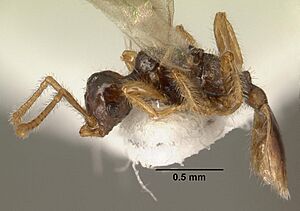Tetramorium inquilinum facts for kids
Quick facts for kids Tetramorium inquilinum |
|
|---|---|
 |
|
| T. inquilinum alate queen from France | |
| Conservation status | |
| Scientific classification | |
| Genus: |
Tetramorium
|
| Species: |
inquilinum
|
| Synonyms | |
|
|
Tetramorium inquilinum is a tiny ant found in Europe. It's a special kind of parasite, meaning it lives off another creature. This ant lives on and gets food from other ants, like the common pavement ant.
What makes T. inquilinum so unusual? It doesn't have any worker ants! Only queens and males exist. These ants rely completely on their host ants for everything. Some scientists have even called it "the 'ultimate' parasitic ant." It was first discovered by a Swiss ant expert named Heinrich Kutter.
Contents
What's in a Name?
When Heinrich Kutter first found this ant in 1950, he gave it the name Teleutomyrmex schneideri. He named it after his teacher and friend, Otto Schneider-Orelli. The name "Teleutomyrmex" means "last" or "final ant."
Later, in 2015, a group of scientists looked closely at this ant again. They decided it actually belonged in a different group, the Tetramorium genus. Because there was already an ant named Tetramorium schneideri, they had to give this special ant a new name. They chose T. inquilinum. The word "inquilinum" comes from a Latin word meaning "inhabitant" or "tenant," which fits perfectly because this ant lives as a "tenant" with other ants.
Where Does This Ant Live?
You can find Tetramorium inquilinum in several places across Europe. It has been seen in the Swiss Alps and the French Alps. It also lives in the French Pyrenees mountains and in Spain. Surprisingly, it has also been found as far away as Turkmenistan.
How Does It Look and Work?
Tetramorium inquilinum has a body that is specially made for its parasitic life. The queens are about 2.5 millimeters long. They have a curved body shape and strong claws.
This ant is quite fragile and cannot take care of itself. Its mouthparts are too small and weak to eat anything but liquid food. Its sting and poison glands are tiny. It also lacks glands that would normally produce food for its young or protect it from germs. Its outer shell is thin, and its brain is small and simple.
How Does It Behave?
Tetramorium inquilinum is very clever. It constantly sends out chemical signals. These signals trick the host ants into thinking the parasitic ants are part of their own family!
Since it's an ectoparasite, T. inquilinum spends most of its life clinging to the backs of its host ants. It especially likes to ride on the host queens. Sometimes, many of these parasitic ants will pile onto one host queen. This can make the host queen so heavy that she can't move at all!
What Does It Eat?
Tetramorium inquilinum gets all its food from its hosts. The host ants bring food back to their nest. Then, they share it by spitting it up for other ants. T. inquilinum takes this liquid food, even the food meant for the host queen!
Reproduction and Life Cycle
Because the host ants feed and care for them so well, Tetramorium inquilinum queens can lay many eggs. Older queens can lay about two eggs every minute! This helps them make sure their species continues, even though they rely completely on other ants.


